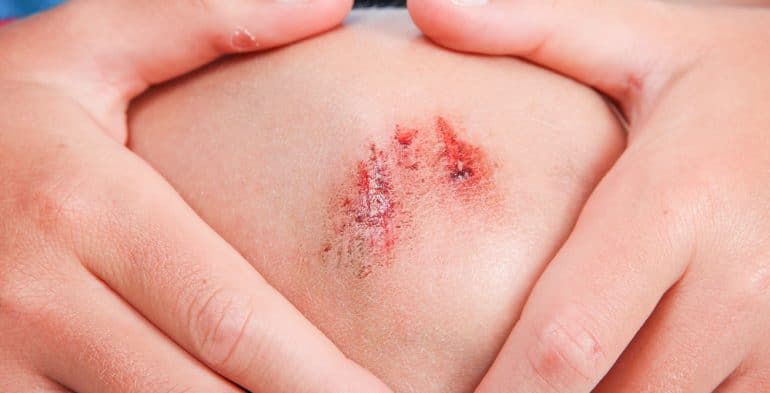
What are Abrasions and Scratches
Most cuts and grazes are minor and can be treated easily at home by stopping the bleeding and cleaning the wound thoroughly and covering with a plaster or dressing. Minor wounds should start to heal within a few days.
How to treat cuts and grazes
An abrasion or scratch is a minor injury, a cut or graze which needs to be cleaned properly to remove dirt, a possible source of infection. The important thing is to promptly remove any foreign bodies from the wound such as dirt or grit and to make sure it is cleared and clean.
Stop the bleeding
Stop any bleeding before applying a dressing to the wound. Apply pressure to the area using a clean and dry absorbent material – such as a bandage, towel or handkerchief – for several minutes.
If the cut is to your child’s hand or arm, raise it above their head to help reduce the flow of blood.
If the injury is to a lower limb, lie down and raise the affected area above the level of their heart.
Clean the wound
When the wound has stopped bleeding, clean it and cover it with a dressing to help stop it becoming infected.
Put the injured part under running tap water or pour water from a glass. Wash your hands and clean the wound with a gentle soap and water. No medicine is needed for a clean wound, nor the use of spirit or iodine which will sting your child’s skin.
To do this:
- wash and dry your hands thoroughly
- clean the wound under drinking-quality running tap water – avoid using antiseptic as it may damage the skin and slow healing
- pat the area dry with a clean towel
- if necessary apply a sterile adhesive dressing, such as a plaster
If a wound is caused by something dirty or rusty or by a pet it is advisable to follow extra precautions.
If in doubt always contact your medical professional.
Do you need to dress a superficial wound?
A dressing is generally not needed for a scratch or graze, although latest advice is to keep a wound moist rather than let it dry out when healing initially. If you feel that the wound might not remain clean or that it may attract flies, cover it with a sterile piece of gauze, available from your pharmacy. Keep it in place with a clean bandage or a clean piece of cloth. Check the wound daily and change the gauze. If the gauze or bandage is stuck to the wound, pour boiled and cooled water to remove it.
If the wound is oozing from the beginning, apply an antibacterial skin ointment on it and then put the gauze over it. If the ointment is not easily available, just sterile gauze will serve the purpose. Once the scab is formed, there is no need to cover the wound.
Keep the dressing clean by changing it as often as necessary. Keep the wound dry by using waterproof dressings, which will allow you to take showers.
You can remove the dressing after a few days, once the wound has closed itself.
Take painkillers if needed
If the wound is painful for the first few days, you can take over-the-counter painkillers.
When to get medical help
It is important to get medical help if there’s a risk the wound could become infected, or you think it’s already infected.
A wound is at risk of infection if:
- it has been contaminated with dirt, pus or other bodily fluids
- there was something in the wound before it was cleaned, such as gravel or a shard of glass
- it has a jagged edge
- it was caused by an animal or human bite
Signs a wound has become infected include:
- swelling, redness and increasing pain in the affected area
- pus forming in or around the wound
- feeling generally unwell
- a high temperature (fever) of 38C (100.4F) or above
- swollen glands
- An infected wound can usually be successfully treated with a short course of antibiotics if necessary
Get emergency medical help if:
- you cannot stop the bleeding
- your child is bleeding from an artery – blood from an artery comes out in spurts with each beat of the heart, and is bright red and usually hard to control
- your child communicates that they are experiencing persisting or significant loss of sensation near the wound or are having trouble moving any body parts
- your child has received a severe cut to the face – they may require urgent treatment to prevent scarring
- your child has received a cut to the palm of their hand and it looks infected – these types of infection can spread quickly
- there’s a possibility a foreign body is still inside the wound
- the wound is very large or the injury has caused a lot of tissue damage
Your child’s wound will be examined to determine whether there’s any risk of infection. They may need a booster injection to prevent tetanus, and their wound may be closed with stitches, strips or special glue before a dressing is applied.
If your child’s wound is at risk of infection, it won’t usually be closed because this may trap any infection inside. Instead, it will be packed with a non-sticky dressing before being covered with a protective dressing until it’s safe to close.







